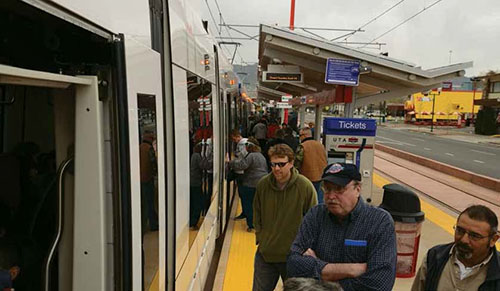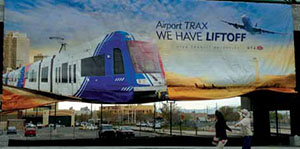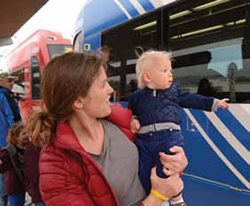Salt Lake City Int'l Welcomes New Light Rail Line

A new light rail link connecting Salt Lake City International Airport (SLC) to the downtown of Utah's capital city opened recently, making it easier than ever for passengers to get to and from the airport. The $350 million extension whisks passengers to the Welcome Center that connects to the south end of Terminal One.
The new TRAX light rail line includes six miles of ballasted and imbedded double track that runs in separate rights-of-way for some stretches and in-street along roadways for other sections. The initial schedule has trains leaving SLC every 15 minutes, with projected ridership reaching 14,000 daily passengers by 2030.
The new link is part of the Utah Transit Authority's Front Lines 2015 program. The six-mile light rail line extends the existing TRAX system from downtown to the airport and provides a direct transfer from a station on top of a newly renovated viaduct to FrontRunner commuter rail, which serves commuters from Ogden to Provo. There are six stations along the route, plus a station and Welcome Center just outside the airport's Terminal One. Passengers can ride from downtown to the airport in about 20 minutes.
The Airport TRAX line began regular service in mid-April and is part of the transit authority's existing Green Line. Special features include art projects at each station and power poles in 23 different colors that create a "ribbons of color" gateway to the city. The spur's biggest feature, however, is the convenience it offers air travelers.
Fast-track to Ticketing
Utah Transit Authority officials are excited about the ease its new link provides passengers. "You get off the train, walk into our Welcome Center, go around the corner - and, boom, you are at the JetBlue ticket counter," enthuses Project Manager Jim Webb.
 One section of the new TRAX line also includes bicycle lanes. Soon, it will be what Salt Lake City Mayor Ralph Becker refers to as the city's first "complete road" - a thoroughfare designed to accommodate mass transit, cars, bicycles and pedestrians.
One section of the new TRAX line also includes bicycle lanes. Soon, it will be what Salt Lake City Mayor Ralph Becker refers to as the city's first "complete road" - a thoroughfare designed to accommodate mass transit, cars, bicycles and pedestrians.
"We are thrilled with the way the new extension of our Green Line to the airport has turned out, and it has been well-received," reports Mike Allegra, general manager for the transit authority. "People who have used it have given us some wonderful feedback. And if early ridership numbers are any indication, the service is everything we hoped it would be."
The global firm of Hatch, Mott, McDonald was the lead systems engineer for the SLC project. As such, it provided traction power design and simulation to validate substation requirements and spacing, overhead contact system engineering and design, communication system design, signals engineering, systems design and integration, combined ductwork design and construction engineering support.
City Airport
Located just five miles northwest of downtown Salt Lake City, SLC is one the closest airports to its city center anywhere in the United States. In addition to being a major hub for Delta Air Lines, it has a strong presence from Southwest Airlines. In total, seven major U.S. airlines serve the two-terminal, five-concourse airport. Last year, SLC served 20 million passengers.
 "We are pleased to be able to offer airport users another transportation option," comments Maureen Riley, executive director of the Salt Lake City Department of Airports. "It is exciting to have an additional component of an integrated transportation system develop."
"We are pleased to be able to offer airport users another transportation option," comments Maureen Riley, executive director of the Salt Lake City Department of Airports. "It is exciting to have an additional component of an integrated transportation system develop."
While airport rail links have been popular in Europe and Japan for decades, they're relatively new in North America. Riders enjoy the faster travel time and easy interconnection with other public transport they provide, and cities benefit from less highway and parking congestion, less pollution and additional business opportunities. The transit links benefit airports by drawing in more passengers via easy access. For airports built within or close to the city limits, extending rapid transit or light rail to airport terminals allows full integration with other public transport in the city.
More Connections
Given the many benefits of linking light rail or other mass transit systems to airports, a variety of cities have projects in the works or under consideration: Sacramento, Oakland, Dallas, Ft. Worth, Phoenix, Denver, Jacksonville and Washington, D.C.
 Las Vegas officials have been discussing extending the famous monorail that runs throughout "the Strip" to McCarran International Airport, and the city's still-in-the-planning-stages reliever, Ivanpah Valley Airport, is projected to include high-speed rail service. XpressWest, a privately funded venture backed by a Las Vegas hotel developer, hopes to connect the new airport in Primm, NV, to Las Vegas, some 30 miles away, in addition to shuttling passengers to and from California.
Las Vegas officials have been discussing extending the famous monorail that runs throughout "the Strip" to McCarran International Airport, and the city's still-in-the-planning-stages reliever, Ivanpah Valley Airport, is projected to include high-speed rail service. XpressWest, a privately funded venture backed by a Las Vegas hotel developer, hopes to connect the new airport in Primm, NV, to Las Vegas, some 30 miles away, in addition to shuttling passengers to and from California.
Even more futuristic is an ultra-high-speed magnetic levitation line, which is proposed to connect Las Vegas and Anaheim, CA, with a station located in Primm. Top speed of the Maglev train is projected at more than 300 miles per hour.
FREE Whitepaper
Fairbanks International Airport Baggage Transport Conveyor Enhanced With Mod Drive™ System
Airports face a host of unique industry challenges, such as meeting efficiency regulations and seeking out the best maintenance practices to reduce costs and keep operations flowing. In today’s current economic climate, any potential cost savings can go a long way.
In 2019, Alaska’s Fairbanks International Airport (FAI) sought to modernize its equipment and operations. They were dissatisfied with the performance of the gearmotors on their baggage transport conveyors and began searching for new suppliers. Regal approached FAI with a solution that could improve equipment performance and simplify maintenance, with the added benefit of energy cost savings: the Hub City® MOD Drive™ system.
This white paper discusses the hardware deployed, the test results and the annualized expectations for ROI.








